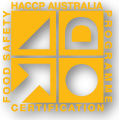The Cold Chain can be summarised as everyone taking part in moving cold and frozen food products from the source to the consumer. Compliance is vital in logistics with so many parts of the chain. Consumers barely notice when it is done right because their food is safe. However, non-compliance with the guidelines can create unsafe foods destined to make consumers ill.
Food moves further than ever from its supplier to the consumer. According to the Australian Cold Chain Guidelines, food is moved in and out of refrigeration control an average of 14 times before it reaches a consumer’s table. In a study tracking Cold Chain logistics, a bunch of broccoli went through 39 steps from harvest to dinner plate. This journey included the efforts of 23 operators through 21 stages. When food moves so far from its source, adherence to safety guidelines is crucial.
What are the Cold Chain Guidelines?
The Cold Chain Guidelines are a collection of recommendations on how participants in the chain can adhere to best practices. Even though the guidelines set the Cold Chain Conditions, they do not outweigh Australian legislation or agreements made regarding compliance.
The Three Core Cold Chain Conditions-
The three Cold Chain conditions provide a framework to ensure the safety of products shipped through the Cold Chain. The conditions are,
Never Warmer than Rule
This rule ensures chilled and frozen foods are kept at an acceptably cold range throughout the products’ journey and are never held at temperatures higher than the set limits.
For Example
- Ice cream and other frozen foods should never be warmer than -18C°
- Chilled foods should never be warmer than between 0C° and 4C°.
Maximum Out of Refrigeration Rule
This rule regulates how long chilled or frozen food may safely be out of refrigeration. Typically, this is regarding when food is being transported or unloaded from the truck.
For Example
- Refrigerated food unloaded in room temperature conditions (5°C to 15°C) can be held for no longer than 20 minutes. However, there is no maximum time limit if unloaded into refrigerated conditions.
- Frozen foods unloaded in a room temperature environment have a maximum time out of refrigeration of 20 minutes. However, if frozen foods are unloaded into refrigerated areas, the maximum time out of refrigeration is 90 minutes.
First Expiry First Out Rule (FEFO)
This rule governs stock rotation. If products with short expiry arrive after products with long expiry, the short-expiry products must be sold first to prevent spoilage. It is safe to hold long-expiry products for a longer period of time.
It is important to note that the manufacturer is in charge of indicating these rules on the packaging of their products. Additionally, manufacturers must pass on all regulations to each part of the cold chain.
Other Cold Chain Guidelines
In addition to the three core conditions, there are a number of transportation guidelines for the Cold Chain. These include,
- Do routine maintenance such as defrosting and cleaning walls, floors, mats and refrigeration units.
- Regularly check seals on doors and replace them as needed
- Check and record the temperature of the refrigerated truck when a new product is loaded.
- Immediately adjust any temperatures that are not within the correct parameters.
- Ensure products are at the preferred temperature when loaded onto the truck. This is because refrigerated trucks are designed to maintain product temperature and do not adjust it.
- Separate loads with mixed temperatures to ensure all products are at the correct temperatures.
- Utilise plastic curtains, secondary doors and insulated containers to minimise heat transfer if truck doors are opened and closed frequently.
- Avoid overloading the refrigerated truck, as this limits air circulation and allows temperature changes.
- Place fresh, chilled, and frozen products on separate pallets.
- Schedule deliveries so there is sufficient time between stops for the truck to regain the correct temperature. Otherwise, warm air entering the truck at frequent intervals will reduce the proper temperature of the products.
Why Compliance is Important for Refrigerated Transport
Maintaining the reliability of the Cold Chain comes down to the matter of public health and safety. Food safety cannot be guaranteed unless every person and business involved in the Cold Chain actively adheres to the guidelines.
At Bossna Logistics, we are committed to maintaining the Cold Chain’s integrity and adhering to its guidelines for refrigerated transport. We are committed to the safe and timely transport of all goods in our care and will go above and beyond to ensure public safety. To learn more about how Bossna Logistics can simplify your business, feel free to contact us.






